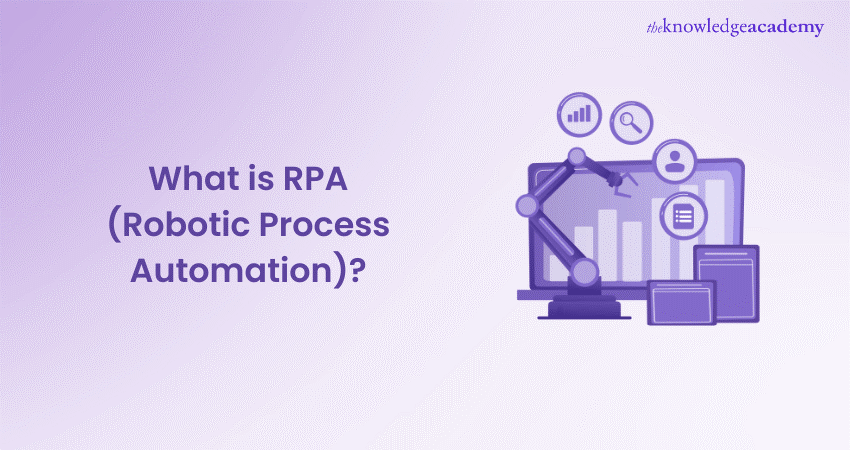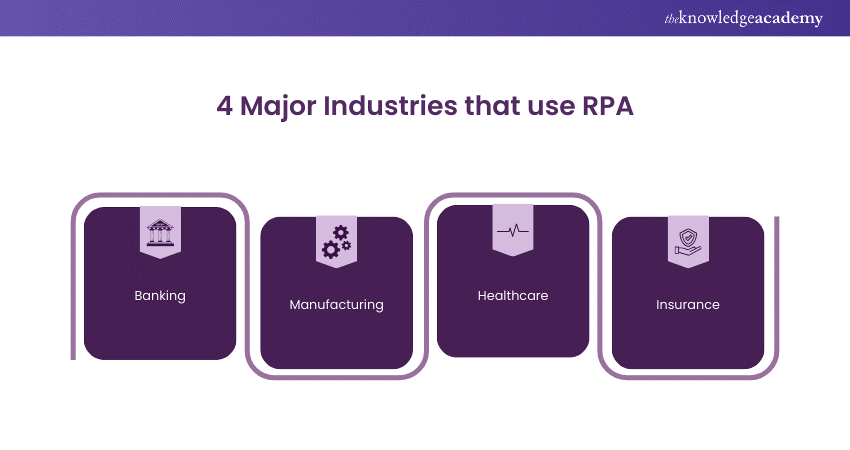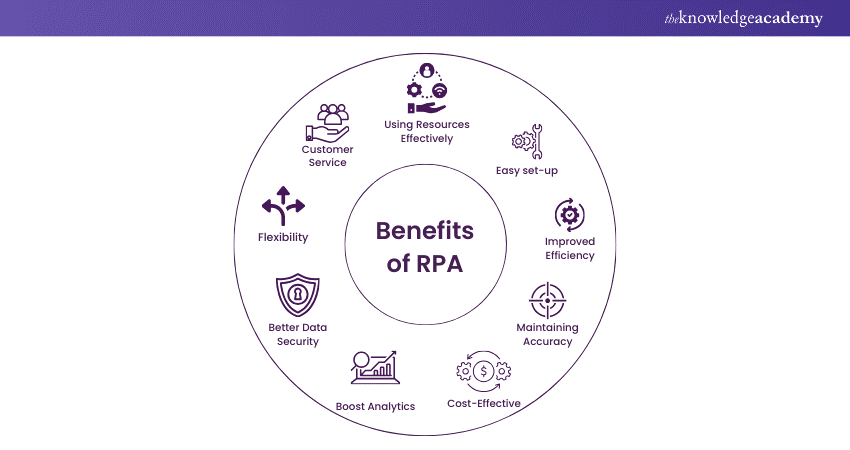We may not have the course you’re looking for. If you enquire or give us a call on 01344203999 and speak to our training experts, we may still be able to help with your training requirements.
Training Outcomes Within Your Budget!
We ensure quality, budget-alignment, and timely delivery by our expert instructors.

We live in a world where technology evolves every day, with the intent of making our lives simpler. Automation has been a huge step in this direction, largely benefitting organisations as they promote quick growth. Robotic Process Automation (RPA) is a type of automation technology. According to the Deloitte Global RPA Survey, around 78% of the current users of RPA are expected to invest more in it over the next three years.
Although the figures show that RPA is widely used, some organisations are still sceptical about introducing the technology to their workers. This is mainly because of the lack of knowledge surrounding that concept.
In this blog, you will learn what is Robotic Process Automation (RPA), why it is an important tool in automation, and its process. Learn more!
Table of contents
1) Meaning of RPA
2) History of RPA
3) How does RPA work?
4) Who uses RPA?
5) Benefits of RPA
6) Challenges and limitations of RPA
7) Conclusion
Improve your business operations by learning about one of the fastest-growing technologies today. Sign up for our Robotic Process Automation Training course now!
Meaning of RPA
Since we have covered Robotic Process Automation or RPA’s meaning, let’s learn what it’s about. RPA Is defined as an automation software that can instruct machines to take over for humans dealing with repetitive tasks. It keeps track of the operations carried out on a system by a human, and then mimics the same when that operation is demanded again.
The objective of RPA is to reduce the time and money being wasted on mundane tasks in organisations. Anything ranging from copy-paste functions to movement of files, RPA carries it out with minimal to zero errors and as quickly as possible. Thus, organisations started highly favoring RPA, for it ensures a considerable improvement to your business.
History of RPA
The first few elements of Robotic Process Automation or RPA were introduced in the early 2000s. It all started with the automation of User Interface (UI) testing. Around that time, organisations were slowly becoming aware of the need to speed up their operations, if they wanted to sustain a successful business. This led to different types of UI testing and Quality Assurance (QA) automation scripts.
Soon, the extraction of data from applications to use for other purposes was also automated. This led to specific industries adopting the concept of Robotic Process Automation or RPA, as it was proved to improve efficiency of businesses like Banking that had to handle a lot of data. RPA pioneered the reduction of paperwork that helped in its growth and popularity.
By 2012, the economic state of the world was worsening. At the time, companies wanted cost-effective solutions for their digital problems. RPA or Robotic Process Automation was the simplest and most powerful solution for their economic and efficiency issues. RPA was finally validated by large scale businesses. Enterprise automation skyrocketed the popularity of the technology.
Today, Robotic Process Automation is in the process of undergoing standardisation, to make it accessible to companies of all sizes. The exorbitant fee required to avail RPAs services need to come down considerably for small-sized businesses to start using it. One of the measures being taken to tackle this issue, is to establish RPA ‘as-a-service' model by partnering with Managed Service Providers (MSPs).
Learn about open span solution development and web integration. Sign up for our OpenSpan RPA Training course now!
How does RPA work?
Robotic Process Automation or RPA relies on information from your systems, networks, and applications to function. It integrates with applications in various ways, depending on the type of platform the business works on. Fundamentally, RPA studies the way humans perform operations on computers and delivers results in the same essence. Let us look at some types of RPA and its tools involved in solving issues.
RPA bots
Imagine tireless, software-based assistants working across all repetitive tasks on your computer. That is the power of RPA bots. These digital workers will follow human actions by interacting with your diverse applications and systems to automate dreary processes.
Think data entry, form filling, report generation, or sending emails—a host of tedium that RPA bots do flawlessly while freeing human employees for far more strategic work. RPA bots are user-friendly, allowing businesses to automate tasks without the need for any in-depth coding know-how.
They improve efficiency, accuracy, and productivity while minimizing human errors. However, unstructured or unexpected data situations might be problematic for RPA bots, meaning that they are best for rule-based duties. With technology on the rise, RPA bots are emerging and help smooth workflows in various industries.
RPA tools
RPA tools allow users to design, deploy, and manage a virtual workforce – RPA bots. It works like the tools are giving an orchestra conductor, guiding the RPA bots wherever they are executing tasks in an automated form.
Most popular RPA tools offer a visual interface where users graphically record their actions on a computer. The recording sequence is then the blueprint for the bot to execute the task with precision at any time. Advanced tools include exception handling, in which the bot can discover unexpected situations and take a pre-defined action.
Some are essential script-form RPA tools with flavors, while others integrate with AI, bringing more intelligence to the automation. That said, the correct RPA tool depends on the complexity level within your tasks and the desired customization level. By leveraging these tools, businesses can unlock the full potential of RPA and achieve significant efficiency gains.
Join Blue Prism Training to learn how to build, test, publish, and manage a Blue Prism Automation.
Who uses RPA?
RPA is used the most in industries that handle large amounts of data. This includes the fields of Finance, Banking, Healthcare, Insurance, and more. Organisations all around the globe are adopting RPA. Here are a few of the chief organisations that make use of RPA.

RPA is used the most in industries that handle large amounts of data. This includes the fields of Finance, Banking, Healthcare, Insurance, and more. Organisations all around the globe are adopting RPA. Here are a few of the chief organisations that make use of RPA.
a) Banking: It is an industry that has to deal with vast amounts of data on a daily basis. Since they deal with sensitive information regularly, the precision of data entry and extraction also matters.
The margin for error is be very narrow. This is why RPA works well for the Banking industry. Most of their tasks can be automated. RPA saves time and increases the speed with which tasks get done.
b) Manufacturing: Manufacturing is a huge sector with multiple sub-sectors. This involves supply chain management, inventory management, and more. RPA helps in streamlining administrative tasks, invoice processing, and even risk management, to name a few.
It saves a ton of time and helps in managing routine and mundane tasks. Any kind of task like recording minutes of meetings or responding to emails, can be taken over by RPA and make your business more efficient.
c) Healthcare: The Healthcare industry also demands inexcusable accuracy when it comes to storing data. The sensitive nature of data can sometimes be an additional pressure for the administrative sector of this industry. Automating such tasks results in lesser wait time for patients and more insightful reports on their histories.
As automation lifts a little weight off them, professionals get to focus on their patients more. The newly obtained time can be used to contribute to patient care in various ways. Thus, the healthcare sector is one of the prominent fields where RPA is used regularly.
d) Insurance: The Insurance sector is always working. They face a daily struggle of juggling between satisfying their customers and complying to the various company and legal policies. From back-office tasks to payouts, there are various repetitive tasks that becomes difficult to handle.
RPA helps in bringing down the workload by taking over such tasks, thereby ensuring faster management. This frees up time for employees to work on other areas. RPA also gives them time to focus on customer service, which is an important aspect to any successful business.
Explore the world of Robotic Process Automation by learning the basics. Sign up for our Robotic Process Automation using UiPath course now!
Benefits of RPA

As discussed above, there are several industries to which RPA can be majorly useful. The cost-effectiveness and speed at which tasks get completed are not the only reasons why you should implement RPA for your business. Let us look at the top 9 benefits of using RPA for your business.
a) Easy Set-up: The word ‘Robotic’ in RPA takes your mind to various places. It is a relatively unknown concept that might fester pre-conceived notions about the difficulty in using it.
Thus, whenever business owners think about adopting RPA, they are carrying a constant fear regarding the time and money that would take to implement it. But RPA implementation takes very little effort and does not need API setup. RPA saves companies a lot of time and money.
b) Improved Efficiency: The major benefit of choosing RPA for your business is that it gives you the best of both worlds. Human resources and RPA tools both contribute to maximum efficiency as they are assigned with an optimal level of work.
Technology, unlike humans, does not fall sick. RPAs do not need breaks nor do they require motivation. They function upon a set of commands 24/7 and hence, increases efficiency.
c) Maintaining Accuracy: Human error is one of the reasons that contribute to compromising the security and integrity of companies. This is unavoidable because mistakes are normal. But a minor error in a business can end up costing you millions. Especially in fields like Finance and Banking, accuracy is key.
Making use of RPA is a viable solution to downright erasing the chance of errors in your daily work. Additionally, RPA produces results faster and leaves you time to focus on other things.
d) Cost-Effective: Business demands might vary depending on the field you’re working in. For instance, if you handle markets that sell seasonal products like Mango, there will be a sudden boost in workload.
Such instances usually lead to owners calling for temporary hires to lessen the stress on the employees. But, choosing Robotic Process Automation ensures constant compliance with your unpredictable business needs. RPA can handle a variety of commands and help you save time and money by not outsourcing help.
e) Boosts Analytics: The more data you procure, the more you can help your business grow. The data can range from research needed for your work to analysing unhealthy work patterns.
Robotic Process Automation or RPA speeds up the process of collecting data that can eventually help in improving your product/service. RPA collects and manages your data efficiently, which helps boost decision-making too.
f) Better Data Security: Data Breach is a major factor that can lead to the weak integrity of companies. Implementing RPA with the right set of regulations and parameters will secure sensitive data important to your organisation.
All kinds of data accesses are kept track of to maintain security. RPA minimises human involvement in handling data and thereby considerably minimises the chances for human error.
g) Flexibility: Organisations are always sceptical about adopting new technology. One of the reasons for this hesitation is legacy systems. Large-scale companies especially find it risky to introduce RPA to legacy systems.
But RPA is adaptable. The RPA tools based on no-code platforms help you avoid replacing legacy systems. RPA bots can always be trained on the legacy software, making your work easier.
h) Customer Service: When it comes to sectors like Healthcare and Insurance, quality patient care and customer service is imperative. Good quality customer service is a time-consuming process but helps in building trust. Sometimes, the routine administrative work keeps employees from investing in this process. This brings down customer satisfaction.
But, with RPA taking over daily repetitive tasks, employees will find more time to invest in customer service. The organisation gets its work done efficiently, while customers are being tended to with employees’ undivided attention. This can help in boosting company ratings.
i) Using resources effectively: Organisations have their workforce divided into two segments – humans and technology. An ideal company functions with the maximised use of either party to produce favourable results. Choosing RPA to take over the tedious work assigned to the employees, helps in significantly bring down the margin for human error.
With Robotic Process Automation or RPA, the accuracy rate goes up and helps in the smooth sailing of your business. At the same time, employees have newly gained free time which can be used to focus on other strategies to help improve the company’s performance. Thus, optimal use of all resources is guaranteed with RPAs.
Improve your business operations by learning about one of the fastest-growing technologies today. Sign up for our Robotic Process Automation Training now!
Challenges and limitations of RPA
As interesting as it is to work with the RPA bots for task automation, there is no panacea. The main challenges and limitations can be outlined in the following way:
a) Brittle: Built RPA bots are excellent at following well-defined instructions, but they are easily thrown off if something minor occurs, such as unexpected changes in the software interface or data format, for which they would need reprogramming.
b) Limited cognitive abilities: RPA bots do not think like humans and have their decision-making capabilities. They struggle with unstructured data, exceptions, or unforeseen situations.
c) Integration challenges: Implementing RPA bots within existing IT systems, particularly legacy software, could become quite complicated. Hence, care needs to be taken that no compatibility problem arises and data silos are not created, which may hamper their smooth working.
d) Process optimisation first: Automating a broken process means replicating only more inefficiencies. Before deploying RPA, it is very much required to detail the analysis and optimization of existing workflows for maximum benefits.
e) Human dependency: Summarily, there will always be a human dependency on the implementation and continual operations of RPA. Human training, monitoring, and even troubleshooting of the bot are indispensable to ensure effectiveness.
f) Job displacement: While RPA can open up new opportunities, it might also disrupt the existing workforce, as some tasks become automated. Businesses will need to consider reskilling and upskilling initiatives.
Conclusion
Robotic Process Automation or RPA has undoubtedly piqued the interest of multiple businesses. But, in spite of being proven useful, there are still companies that are unaware of RPA or sceptical about implementing it. We hope this blog has helped answer your questions like, “What is RPA?” and “What are the benefits of RPA?”.
Learn everything about debugging ROS nodes and visualisation of images. Sign up for our Robot Framework Training course now!
Frequently Asked Questions

The three types of RPA are attended RPA, unattended RPA, and hybrid RPA. Attended RPA requires human intervention, unattended RPA operates autonomously, and hybrid RPA combines aspects of both attended and unattended RPA.

RPA (Robotic Process Automation) involves automating repetitive tasks using software robots, mimicking human actions. Automation, on the other hand, refers to the broader concept of using technology to perform tasks with minimal human intervention, which can include RPA but also extends to other forms of automation.

The Knowledge Academy takes global learning to new heights, offering over 30,000 online courses across 490+ locations in 220 countries. This expansive reach ensures accessibility and convenience for learners worldwide.
Alongside our diverse Online Course Catalogue, encompassing 17 major categories, we go the extra mile by providing a plethora of free educational Online Resources like News updates, Blogs, videos, webinars, and interview questions. Tailoring learning experiences further, professionals can maximise value with customisable Course Bundles of TKA.

The Knowledge Academy’s Knowledge Pass, a prepaid voucher, adds another layer of flexibility, allowing course bookings over a 12-month period. Join us on a journey where education knows no bounds.

The Knowledge Academy offers various Robotic Process Automation Training, including Robotic Process Automation using UiPath Course, Robot Framework Training and OpenSpan RPA Training. These courses cater to different skill levels, providing comprehensive insights into What is Robotics?
Our Advanced Technology Blogs covers a range of topics offering valuable resources, best practices, and industry insights. Whether you are a beginner or looking to advance your skills, The Knowledge Academy's diverse courses and informative blogs have you covered.
Upcoming Business Analysis Resources Batches & Dates
Date
 Robotic Process Automation using UiPath
Robotic Process Automation using UiPath
Thu 9th May 2024
Thu 27th Jun 2024
Thu 18th Jul 2024
Thu 12th Sep 2024
Thu 7th Nov 2024
Thu 12th Dec 2024







 Top Rated Course
Top Rated Course



 If you wish to make any changes to your course, please
If you wish to make any changes to your course, please


